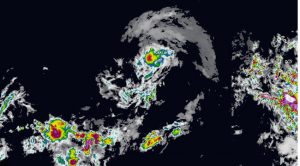 Climatologist at the Antigua & Barbuda Meteorological Services Dale Destin said more named storms are expected than had been previously forecast, as the region enters the more active portion of the 2016 Atlantic Hurricane Season.
Climatologist at the Antigua & Barbuda Meteorological Services Dale Destin said more named storms are expected than had been previously forecast, as the region enters the more active portion of the 2016 Atlantic Hurricane Season.
Yesterday, Destin told OBSERVER media that the forecast has now been upgraded to 15 named storms, and seven of them should become hurricanes, with three being major. In May this year, the initial forecast models showed that there was the possibility of 13 named storms, and six were expected to develop into hurricanes with three becoming major tropical cyclones.
Notwithstanding the updated forecast, Destin is anticipating a near normal season, but pointed out that when compared to the last few years, it is expected that this season could be more active.
“We’re now pretty much in the heart of the hurricane season. The period August to October is traditionally the most active part of the season, with September being the most active month,” he said.
According to Destin, Tropical Storm Fiona formed yesterday about 1,000 miles east of the Caribbean, but based on computer models, it is expected to move away and therefore will not pose any threat to the region.
However, he said there’s the likelihood that more systems will develop since another 10 named storms are expected to materialise before the season is over.
Asked whether the recent showers that Antigua & Barbuda has been experiencing is an indication that the prolonged drought will soon be over, Destin said: “We perform these drought outlooks on a monthly basis and the last set of data analysed suggests that rainfall for August should be above normal, and there’s a 60 per cent chance probability of this happening.
“Additionally, the period August to October should realise an above to near normal rainfall. That suggests a further ease to the drought,” he added.
The weather expert said there are certain types of drought that the Met Office continues to monitor, namely the meteorological or agricultural droughts, and the hydrological and socio-economic droughts.
